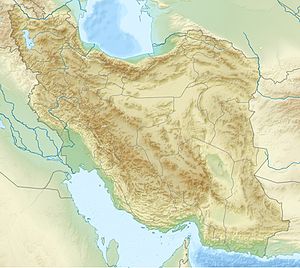The Kharijites, also called al-Shurat, were an Islamic sect which emerged during the First Fitna (656–661). The first Kharijites were supporters of Ali who rebelled against his acceptance of arbitration talks to settle the conflict with his challenger, Mu'awiya, at the Battle of Siffin in 657. They asserted that "judgment belongs to God alone", which became their motto, and that rebels such as Mu'awiya had to be fought and overcome according to Qur'anic injunctions. Ali defeated the Kharijites at the Battle of Nahrawan in 658, but their insurrection continued. Ali was assassinated in 661 by a Kharijite dissident seeking revenge for the defeat at Nahrawan.
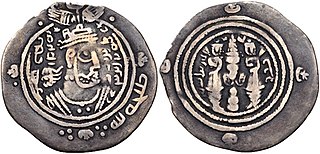
Marwan ibn al-Hakam ibn Abi al-As ibn Umayya, commonly known as Marwan I, was the fourth Umayyad caliph, ruling for less than a year in 684–685. He founded the Marwanid ruling house of the Umayyad dynasty, which replaced the Sufyanid house after its collapse in the Second Muslim Civil War and remained in power until 750.
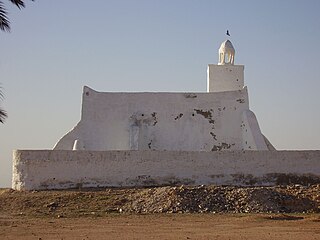
The Ibadi movement or Ibadism is a school of Islam. It has been called by some the third branch of Islam, along with Sunni Islam and Shia Islam. The followers of Ibadism are known as the Ibadis.

Ubayd Allah ibn Ziyad was the Umayyad governor of Basra, Kufa and Khurasan during the reigns of caliphs Mu'awiya I and Yazid I, and the leading general of the Umayyad army under caliphs Marwan I and Abd al-Malik.

Abu al-Mughira Ziyad ibn Abihi, also known as Ziyad ibn Abi Sufyan, was an administrator and statesman of the successive Rashidun and Umayyad caliphates in the mid-7th century. He served as the governor of Basra in 665–670 and ultimately the first governor of Iraq and practical viceroy of the eastern Caliphate between 670 and his death.

Samura ibn Jundab al-Fazārī was a companion of the Islamic prophet Muhammad who fought at the Battle of Uhud in 627 and later participated in the Muslim conquest of Iran in the 630s–640s. In 670–673 he served as the lieutenant governor of Basra under Ziyad ibn Abihi, the supreme governor of Iraq and the eastern Umayyad Caliphate. During his deputy rule over Basra, he is held by the Islamic traditional sources to have ordered wide-scale executions of Kharijites in his jurisdiction. He remained governor of Basra under the Umayyad caliph Mu'awiya I for six to eighteen months after Ziyad's death in August/September 673 until the Caliph replaced him.

Abd Allah ibn al-Zubayr ibn al-Awwam was the leader of a caliphate based in Mecca that rivaled the Umayyads from 683 until his death.
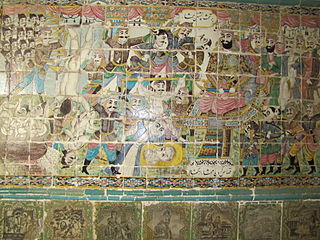
Al-Mukhtar ibn Abi Ubayd al-Thaqafi was a pro-Alid revolutionary based in Kufa, who led a rebellion against the Umayyad Caliphate in 685 and ruled over most of Iraq for eighteen months during the Second Fitna.
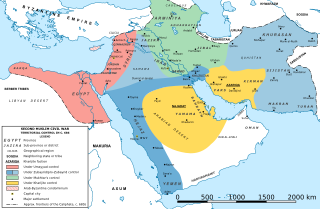
The Second Fitna was a period of general political and military disorder and civil war in the Islamic community during the early Umayyad Caliphate. It followed the death of the first Umayyad caliph Mu'awiya I in 680, and lasted for about twelve years. The war involved the suppression of two challenges to the Umayyad dynasty, the first by Husayn ibn Ali, as well as his supporters including Sulayman ibn Surad and Mukhtar al-Thaqafi who rallied for his revenge in Iraq, and the second by Abd Allah ibn al-Zubayr.
Cursing Ali was a state policy introduced by Mu'awiya ibn Abi Sufyan, the first Umayyad caliph, which mandated publicly cursing Ali ibn Abi Talib, the cousin and son-in-law of the Islamic prophet Muhammad, who was also the fourth Rashidun caliph and the first Shia Imam. Mu'awiya was the incumbent governor of Syria who had rebelled against Ali ostensibly to avenge the previous caliph Uthman, who was in turn assassinated by some provincial dissidents angered by his policies. Ali and Mu'awiya fought the inconclusive Battle of Siffin in 657 CE and remained enemies until the assassination of Ali in 661, which paved the way for the caliphate of Mu'awiya in the same year. The public cursing of Ali continued after Mu'awiya and was finally abandoned some sixty years later by the pious Umar II. The policy likely served as a propaganda measure, and also helped provoke, identify, and then crush the supporters of Ali, whom the Umayyads considered a threat.
Najda ibn Amir al-Hanafi was the head of a breakaway Kharijite state in central and eastern Arabia between 685 and his death at the hands of his own partisans. His emergence formed part of the Second Muslim Civil War and the faction he led stood in opposition to the Umayyad Caliphate, which controlled Syria and Egypt, and the caliphate of Abd Allah ibn al-Zubayr, which controlled the Hejaz and Iraq.
The Najdat were the sub-sect of the Kharijite movement that followed Najda ibn 'Amir al-Hanafi, and in 682 launched a revolt against the Umayyad Caliphate in the historical provinces of Yamama and Bahrain, in central and eastern Arabia.
The Azariqa were an extremist branch of Khawarij, who followed the leadership of Nafi ibn al-Azraq al-Hanafi. Adherents of Azraqism participated in an armed struggle against the rulers of the Umayyad Caliphate, and they declared those who avoided this duty infidels - kafirs - and allowed their murder. Nafi ibn al-Azraq even permitted the killing of women and children of his opponents. At the same time, the Azraqites did not extend the principle of killing “apostates” to Christians and Jews, since they believed that they did not betray the teachings of the prophets Jesus and Moses.
Abu al-Hudhayl Zufar ibn al-Harith al-Kilabi was a Muslim commander, a chieftain of the Arab tribe of Banu Amir, and the preeminent leader of the Qays tribal–political faction in the late 7th century. During the First Muslim Civil War he commanded his tribe in A'isha's army against Caliph Ali's forces at the Battle of the Camel near Basra in 656. The following year, he relocated from Iraq to the Jazira and fought under Mu'awiya ibn Abi Sufyan, future founder of the Umayyad Caliphate, against Ali at the Battle of Siffin. During the Second Muslim Civil War he served Mu'awiya's son, Caliph Yazid I, leading the troops of Jund Qinnasrin against anti-Umayyad rebels in the 683 Battle of al-Harra.
ʿAbbād ibn Ziyād ibn Abīhi was an Arab commander and statesman of the Umayyad Caliphate. A son of the governor of Iraq, Ziyad ibn Abihi, Abbad served as a governor of Sijistan between 673 and 681 under caliphs Mu'awiya I and Yazid I. He led a contingent in the army of Caliph Marwan I at the Battle of Marj Rahit and afterward fought against loyalists of al-Mukhtar al-Thaqafi during the reign of Caliph Abd al-Malik. He later served at the court of the latter's son and successor, Caliph al-Walid I, and played a role in the succession intrigues between al-Walid's son Abd al-Aziz and the caliph's brother, Sulayman.

Abū Ḥarb Salm ibn Ziyād ibn Abīhi was a general and statesman of the Umayyad Caliphate, who later defected to the caliphate of Abd Allah ibn al-Zubayr during the Second Muslim Civil War before returning to the Umayyads' ranks. Salm was appointed by Caliph Yazid I as the governor of Khurasan and Sijistan in 681. During the course of his governorship, he launched several expeditionary raids into the Central Asian regions of Transoxiana, including Samarkand, and Khwarazm. His successes and generous distribution of war booty among his Khurasani Arab troops gained him wide popularity with them, but after Yazid died, Salm was not able to maintain their loyalty to the Umayyads for long. After his troops and chosen successor, Abd Allah ibn Khazim al-Sulami, gave their allegiance to the rival caliphate of Abd Allah ibn al-Zubayr, Salm made for Basra. There, he ultimately joined Ibn al-Zubayr's camp, but was imprisoned in Mecca by the latter nonetheless. After paying a large bribe, he was released and following Ibn al-Zubayr's death at the hands of the Umayyads in late 692, he was reappointed the governor of Khurasan. However, he died before he could resume his duties.
Sa'id ibn Uthman ibn Affan al-Umawi was an Umayyad general and military governor of Khurasan in 676–677 during the reign of Caliph Mu'awiya I. He was a son of Caliph Uthman and a one-time seeker of the caliphate in 675/76.
Qays ibn al-Haytham al-Sulamī was an Arab commander and administrator in the service of the Rashidun, Umayyad and Zubayrid caliphates. Under the caliphs Uthman and Mu'awiya I he served at time as the sub-governor of Khurasan and the cities of Nishapur and Marw al-Rudh. He was from a prominent Arab family in Basra and was a leader among the tribal nobility of that city until his death after 684.
Aslam ibn Zurʿa ibn ʿAmr ibn Khuwaylid al-Ṣāʿiq al-Kilābī was a prominent Arab chieftain of the Qays tribal faction in Basra and Khurasan and served as the governor of Khurasan in 675 and 677–679. In the period between his two terms, he continued to wield significant influence in the province alongside the governor Sa'id ibn Uthman. Unlike his predecessors and many of his successors, Aslam did not undertake further conquests from the Khurasan frontier into Transoxiana. Regarding possession of war booty and tribute, he consistently defended the interests of the Arab tribesmen in Khurasan, who made up the core of the Umayyad Caliphate's forces there and insisted on controlling the funds due to the high costs of their military activity, against the demands of the central government in Syria. Aslam was known to have imposed heavy taxation on the population of Khurasan. He was arrested by Qays ibn al-Haytham al-Sulami, who extracted from him 300,000 silver dirhams. Aslam was later dispatched to suppress a small Kharijite force in Ahwaz in 680/81, but was defeated. His son Sa'id and grandson Muslim also held high office.
Abu Yahya Abdallah ibn Yahya ibn Umar ibn al-Aswad ibn Abdallah ibn al-Harith ibn Mu'awiya ibn al-Harith al-Kindi, better known by his laqab of Talib al-Haqq, was the leader of an Ibadi revolt against the Umayyad Caliphate in southern Arabia during the Third Fitna.
